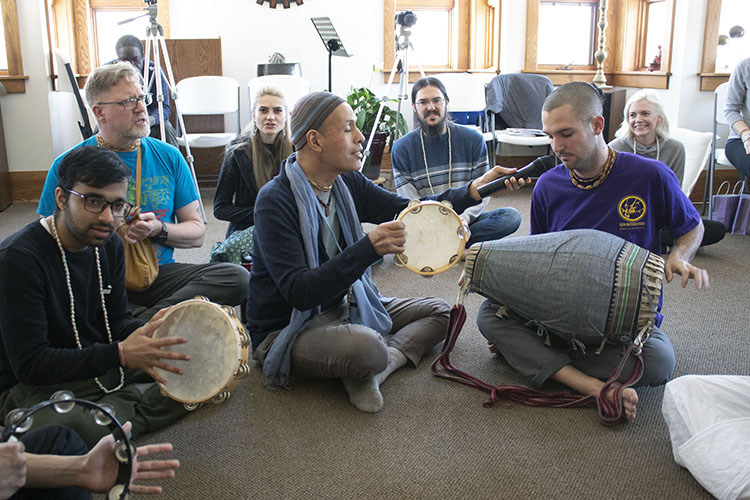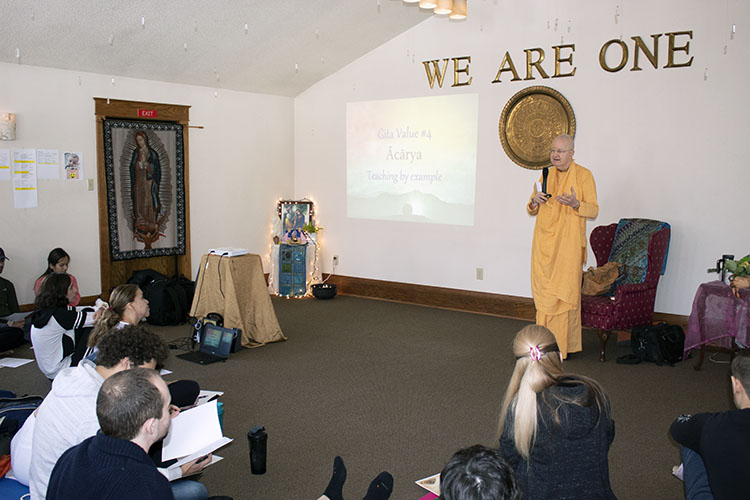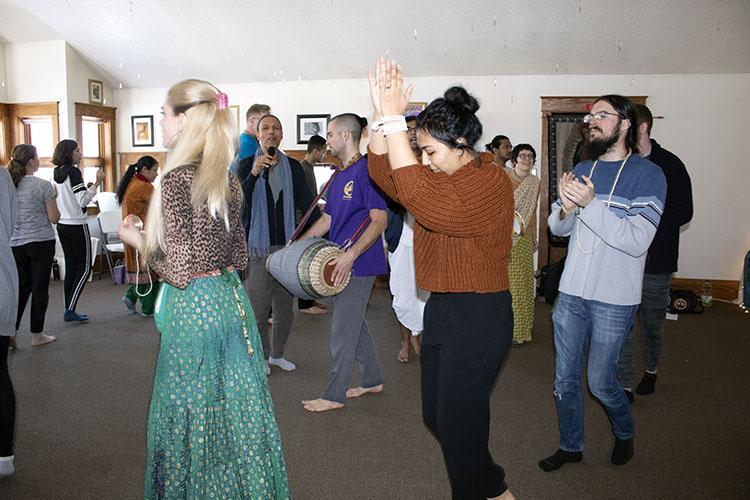There is no room for shame in the yoga circle at Sacred Sounds Meditation, a Bhakti yoga club that meets at MSU Mankato. Each member accepts where the others are which opens space for emotional, mental, and spiritual growth.
Incense burns near the yoga circle to set a mood of mindfulness. A sense of joy and well being hover in the room, welcoming visitors who may be feeling apprehensive about a new social setting.
Most of the members wear a variety of clothes they consider the most comfortable, including pajamas. Dolly Baruah, a native of India and member of the club, clarified misunderstandings that most Westerners have about yoga, including associating it with a particular clothing style.
“There is no special yoga clothing in India,” Baruah said, adding that most people mistake yoga as physical exercise rather than a journey of spiritual growth beginnings in the heart.
Baruah also noted that the original emphasis of yoga is for reflection and quieting the mind to awaken the soul, which contrasts with what it has often become in the west, sometimes opening the door to body shame and narcissism.
Most people mistake yoga as physical exercise rather than a journey of spiritual growth beginnings in the heart
She said, “Yoga comes from the Sanskrit root Yuj which means to link up. People in India who practice yoga maintain a goal of suppressing all activity of the body, mind, and will.” In that way, the self realizes that it is distinct from those three and attain liberation. They practice yoga exercises to acquire bodily or mental control or well-being. The full meaning of yoga in Sanskrit means union of the individual consciousness or soul with the broader Universal consciousness.
Imagery & Meditation
“Today we are going to travel to your heart,” Baruah announced, at a recent meeting.
Even though she was the former leader of Sacred Sounds Mediation, she prefers to be considered just a member and explained that the club has no formal leadership. She has adopted the yoga principle of humility, that all people are considered equal regardless of their race, gender, or status since the purpose of yoga is to unify rather than divide.

As the members begin, she punctuates her phrases, allowing the group to effectively meditate. “Feel the vibrations of your heart,” she continued, “go deep inside your heart.”
She invited the group to envision a glowing white light falling on their faces and their bodies beginning to feel cool. She asked them to picture walking along a path, seeing a tree, a butterfly on a branch. The visuals help still a racing mind if they have experienced a rough day, or if they battle anxiety or depression. Once club members have adopted a practice of constant meditation, they are able to become more mindful throughout their day.
After the visualization exercise, the group begins to chante. Participants use their own Japa beads but if participant is new, the club offers a gift of beads from the collection they keep on hand for such a purpose.
While yoga practitioners use many different mantras, their most common one is Hare Krishna which consists of three Sanskrit names of the Supreme Being: “Hare,” the feminine potency of the Divine, “Krishna,” all-attractive being, and “Rama,” which means hold all pleasures. Chanting the mantra is like a song which calls the presence of the Divine. According to the Vedas, one set of Hindu scriptures, Hare Krishna is called Maha Mantra and considered the greatest mantra. There is scientific evidence that the mantra helps with anxiety and depression.
“It can be chanted by anyone,” Baruah said, “not necessarily just beginners.”
Beads
While Japa beads can be of any color, their number amounts to 108 as a rule and is made from Tulsi, a plant considered sacred in India. Practitioners use the beads to keep track of their rounds. One round is completed after they chant 108 times — one pass through the string of beads. The Japa beads have a head bead, called a guru, that protrudes from the string and is capped with a tassel. The guru marks progress around the beads as an alternative to watching the clock.
Before chanting, beads are held loosely between the participant’s hands and are looped between the second and pinky fingers. The index finger is not used since it is considered a symbol for the ego in the Eastern World.
Beliefs
Beliefs are deeply embedded in the practice of yoga. At the heart of those beliefs is the need for a humble attitude and approach to life, as well as in living in the present with a grateful spirit.
Most stress originates from desire, according to His Holiness Romapada Swami. Swami recently spoke at the Bhakti Yoga Seminar at the Hope Interfaith Center, a three-day event organized by the Club.

In his years traveling internationally, Swami has observed that many people seek material pleasures to escape their difficult lives or to fill their emptiness. People strive for a comfortable lifestyle. “And yet they still struggle,” Swami mused. “Why is that?” He paused to allow time for reflection. “They are a slave to their mind,” he offered. He added that when a person lets go of the material nature, they realize what happiness means. “You are a spiritual spark and that is enough,” Swami said. “You are enough. When you’re in touch with who you are within, you are enough.”
Recently, Anastasia Viland, a dedicated member of Sacred Sounds Meditation, was promoted to lead group, along with another member, Tribhuvan Thakur. Viland has practiced yoga since she was 13, but her understanding has grown much since then. She had the common misconception that yoga was about physical fitness and would frequently exercise with her mom. A year and a half ago, she joined the club without realizing what she was getting into and her experience with the members pleasantly surprised her.
“People were very accepting and very happy,” she remembered. “The more I kept going to the club, the happier I was with myself and my situation. Before I would have a complete anxiety attack with the little things, but now it doesn’t matter compared to the bigger picture.”
According to Viland and the group, being part of the bigger picture is the recognition that all entities are one, therefore the awareness that personal actions affect the environment. Viland admits she wrestles occasionally with material desires, for example, owning twelve sarees. She does, however, stitch them back together when they rip until they become completely unusable. “When I’m wearing them, I am at my true self,” she said.

Finally
“All yoga is for one reason,” Baruah said, “to unite with the Divine. You eat to satisfy the stomach, which is the main goal, but in the process of satisfying the stomach, you also get some vitamins from the food you eat and this helps different parts of the body. But your goal is to satisfy the stomach. Similarly, I am comparing the stomach with the Divine. If you satisfy the Divine, your other necessities are automatically fulfilled. Same goes for practicing yoga – when you focus on the goal of linking up with the divine, the main goal, you automatically get other benefits by doing yoga such as good health, good body postures, etc. But the goal of yoga is self-realization, ‘Who I am.’”
Baruah also described the goal of uniting with the Divine as like the goal of getting to your house. You might take a bus, a bike, or your own vehicle. It is your devotion that enables you to reach your destination since there are other forms of yoga besides Bhakti.
Baruah’s desire is to open the community’s understanding about the practice of Bhakti Yoga.
If You’re Interested
Considering current world events, the Sacred Sounds Meditation Club is not currently meeting. The club encourages anyone who is interested in Bhakti Yoga to visit their Facebook page or email one the club members. Any of them will be happy to answer any questions.
- Dolly Baruah – dolly.baruah2@gmail.com
- Anastasia Viland – anastasia.viland@mnsu.edu
- Tribhuvan Thakur – tribhuvan.thakur@mnsu.edu
Sacred Sounds Meditation Club Facebook Page
When the club resumes meetings, you can find the details on MankatoLIFE’s calendar.



